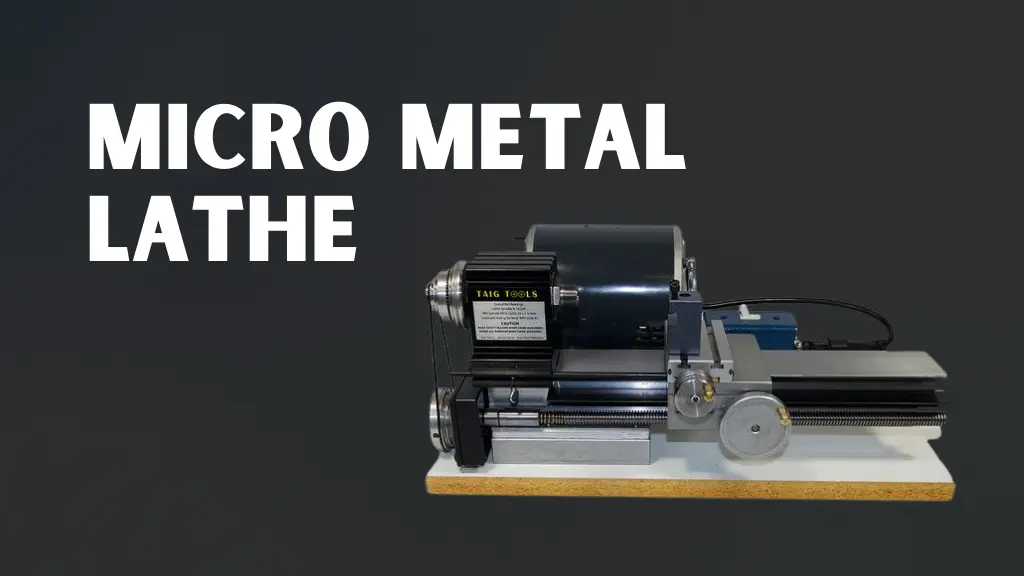A micro metal lathe is a compact, versatile, and precise tool designed for machining small metal components. Unlike industrial-sized lathes, micro lathes cater to hobbyists, small workshops, and engineers who need accuracy in limited spaces. Whether you are creating miniature models, intricate parts, or performing fine repairs, a micro metal lathe provides the control, flexibility, and reliability necessary for precision work.
In this guide, we’ll explore everything from key features and types to practical applications, maintenance tips, and buying advice. By the end, you’ll understand why investing in a micro metal lathe can elevate your craftsmanship and efficiency.
What is a Micro Metal Lathe?
A micro metal lathe is a scaled-down version of a conventional metal lathe, optimized for precision and small-scale projects. It typically consists of a bed, headstock, tailstock, carriage, and spindle, but with dimensions suitable for small workpieces. These machines are ideal for hobbyists, jewelers, model engineers, and DIY enthusiasts.
Key Features of a Micro Metal Lathe
- Compact Size: Fits easily on workbenches or in small workshops.
- High Precision: Accurate cuts, essential for miniature parts.
- Variable Speed Control: Allows adjusting spindle speed for different metals.
- Durable Construction: Often made with cast iron or steel for stability.
- Ease of Use: User-friendly controls and setup suitable for beginners and experienced machinists alike.
- Versatile Tooling Options: Compatible with various cutting tools and accessories.
- Adjustable Tailstock and Carriage: Ensures precise alignment and consistent results.
Types of Micro Metal Lathes
Micro metal lathes vary based on construction, power source, and intended use. Understanding the types can help you select the right model.
1. Benchtop Micro Lathes
These are compact, lightweight, and designed to sit on a table or workbench. Ideal for small projects and educational purposes, they often include basic accessories and offer moderate precision.
2. Hobbyist Micro Lathes
Perfect for DIY enthusiasts or model makers. These lathes often include essential accessories and provide moderate precision for small projects. They are generally user-friendly and do not require advanced skills to operate.
3. Professional Micro Lathes
Engineered for small workshops or precision machining industries. They offer advanced features like higher spindle speeds, digital readouts (DRO), and improved rigidity. Professional lathes are suitable for producing high-precision components consistently and efficiently.
Advantages of Using a Micro Metal Lathe
Micro metal lathes are compact yet highly functional machines that offer numerous benefits for hobbyists, educators, and small-scale professionals. They combine precision, versatility, and affordability in a single package. Understanding their advantages helps users maximize productivity and achieve professional-quality results.
-
Precision Machining
Micro lathes allow for highly accurate cutting and shaping of miniature components. This precision is critical for small parts in model engineering, electronics, and jewelry making. Tight tolerances ensure parts fit perfectly in assemblies. The ability to achieve detailed accuracy makes micro lathes invaluable for delicate projects.
-
Cost-Effective
Micro lathes are much more affordable than full-sized machines. This makes them accessible for hobbyists, startups, and small businesses. Despite the lower cost, they still provide professional-quality results. Investing in a micro lathe delivers excellent value without compromising functionality.
-
Space-Saving
Micro lathes are compact and suitable for small workshops, home garages, or classrooms. They require minimal floor space compared to full-sized lathes. Their portability makes it easier to rearrange or transport when necessary. This space efficiency makes them ideal for hobbyists and limited-workshop environments.
-
Skill Development
Operating a micro metal lathe helps users develop essential metalworking skills. Beginners can learn about measurement, tool handling, and machining techniques. Advanced users can refine precision, efficiency, and advanced techniques. The lathe serves as an educational platform for hands-on learning.
-
Time Efficiency
Micro lathes speed up small-scale production, prototyping, and repetitive tasks. Quick setup and precise operation reduce time spent on adjustments. They allow users to complete projects faster without compromising accuracy. Time efficiency makes them valuable for hobbyists and professionals alike.
-
Durability
With proper maintenance, micro lathes can last for decades. Regular lubrication, cleaning, and inspection prevent wear and extend machine life. High-quality construction ensures reliability over long-term use. Investing in a durable micro lathe provides years of consistent performance.
Applications of Micro Metal Lathes
Micro metal lathes are highly versatile tools that serve both hobbyists and professionals. Their compact size allows for precision work on small components while still offering the functionality of larger machines. These lathes are widely used across industries, education, and DIY projects. Understanding their applications helps users maximize their capabilities.
1. Model Engineering
Micro lathes are ideal for building miniature trains, cars, aircraft components, and other scale models. They allow for precise shaping of tiny parts with high accuracy. Hobbyists can create functional and detailed models efficiently. The ability to work on small-scale projects makes them indispensable in model engineering.
2. Jewelry Making
Jewelry makers use micro lathes to cut intricate designs and patterns on metals like silver, gold, and brass. They enable precise shaping, drilling, and finishing for custom pieces. This precision allows artists to produce high-quality, detailed jewelry. Micro lathes enhance creativity while maintaining consistent results.
3. Electronics
In electronics, micro lathes are used to create precise metal casings, connectors, and other small components. Accurate machining ensures proper fit and function in devices. Small-scale parts that require tight tolerances benefit greatly from micro lathe precision. This application supports innovation and quality in electronics manufacturing.
4. Repair and Restoration
Micro lathes are perfect for restoring antique tools, instruments, or mechanical parts. They allow careful machining without damaging delicate or valuable components. Users can replicate or replace worn-out parts accurately. These lathes are essential for preservation and restoration projects.
5. DIY Projects
From custom screws to small mechanical assemblies, micro lathes empower DIY enthusiasts to create functional parts at home. They allow experimentation with materials and designs. Small-scale projects benefit from precision and repeatability. Micro lathes open up a wide range of creative possibilities for makers.
6. Educational Use
Micro lathes are valuable teaching tools in schools and workshops. They help students learn about machining, engineering principles, and material properties. Hands-on experience develops technical skills and understanding. These lathes provide a safe, practical introduction to metalworking concepts.
How to Choose the Right Micro Metal Lathe
Choosing the right micro metal lathe is essential for achieving precise and efficient machining results. Several factors influence the decision, from workpiece size to long-term maintenance. Understanding these criteria ensures you select a machine that meets your specific needs. A well-chosen lathe enhances productivity and delivers professional-quality results.
-
Workpiece Size
Ensure the lathe can accommodate the maximum diameter and length of the projects you plan to work on. Smaller lathes may limit the size of parts you can machine. Measure your typical workpieces and compare them to the lathe’s specifications. Choosing the correct size prevents operational limitations and improves efficiency.
-
Spindle Speed
Consider spindle speed options when selecting a lathe. Higher speeds are suitable for softer metals and achieving fine surface finishes. Adjustable speed ranges allow versatility for different materials. Proper speed control improves cut quality and reduces tool wear.
-
Construction Material
The material of the lathe’s bed and frame affects stability and vibration. Cast iron provides rigidity and reduces vibration for precise cuts. Aluminum models are lighter and easier to move but may flex under heavy loads. Choose a construction material that balances portability with machining accuracy.
-
Precision Features
Look for features like digital readouts, fine feed adjustments, and smooth carriage movement. These enhance accuracy and control during machining operations. Advanced precision features make complex tasks easier to perform. Investing in precision capabilities improves overall work quality.
-
Accessories
Check what tools and attachments come with the lathe, such as chucks, tool posts, or faceplates. Accessories expand the lathe’s functionality for a wider range of projects. Having the right accessories reduces the need for aftermarket purchases. Proper tooling enhances versatility and efficiency.
-
Budget
Compare features relative to cost to ensure you get maximum value for your investment. Higher-priced models may offer better precision, durability, and included accessories. Determine which features are essential for your projects. Balancing cost and capability ensures a smart purchase decision.
-
Noise and Vibration
Higher-quality models are designed to minimize vibration and noise. Less vibration improves cut accuracy and prolongs the life of both tools and the lathe. Reduced noise also creates a safer and more comfortable working environment. Consider models with robust construction and vibration-dampening features.
Maintenance Requirements
Evaluate the ease of performing routine maintenance on the lathe. Look for accessible lubrication points, replaceable belts, and easy-to-service components. Regular maintenance ensures long-term reliability and consistent performance. Choosing a lathe that is simple to maintain reduces downtime and repair costs.
Operating a Micro Metal Lathe
Proper operation ensures accuracy and longevity. Here’s a step-by-step overview:
Basic Steps:
- Secure the Workpiece: Mount the material between the headstock and tailstock.
- Select the Tooling: Use the correct cutting tool for your project.
- Adjust Spindle Speed: Match the speed to material type and desired finish.
- Perform the Cut: Feed the tool slowly and steadily for precision.
- Check Measurements: Frequently measure workpieces to maintain accuracy.
- Finishing: Use fine sandpaper or polishing tools for a smooth surface.
Safety Tips:
- Always wear safety goggles and gloves.
- Keep loose clothing and hair away from the spindle.
- Ensure proper lubrication to avoid overheating.
- Keep the work area clean to prevent accidents.
- Never leave the machine running unattended.
Maintenance Tips for Longevity
Proper maintenance is essential to ensure a micro metal lathe performs accurately and lasts for years. Regular care prevents wear, improves safety, and maintains consistent machining quality. Following a maintenance routine also reduces unexpected downtime. Attention to detail during inspections preserves both tools and workpieces.
-
Lubricate Moving Parts
Regularly lubricate all moving components, including the spindle, carriage, and lead screws. Proper lubrication reduces friction and prevents premature wear. It also helps protect metal surfaces from rust and corrosion. Consistent lubrication ensures smooth operation and maintains cutting precision.
-
Clean After Each Use
After every session, remove metal shavings, dust, and debris from the lathe. Use a brush or compressed air to reach tight spots. Cleaning prevents buildup that can affect movement and accuracy. Maintaining a clean machine extends the lifespan of both the lathe and its tools.
-
Check Alignment
Periodically verify that the headstock and tailstock are parallel and aligned. Misalignment can cause inaccurate cuts and uneven wear on tools. Use precision instruments such as dial indicators for accuracy checks. Maintaining alignment ensures high-quality results in all projects.
-
Tighten Bolts
Vibration during operation can loosen bolts and fasteners over time. Regularly check and tighten all critical screws and nuts. This prevents parts from shifting and affecting precision. Properly secured components contribute to consistent, safe machining.
-
Replace Worn Parts
Monitor chucks, belts, bearings, and other wear-prone components. Replace any parts that show signs of damage or wear immediately. Using worn parts reduces accuracy and may cause further damage. Timely replacement maintains the lathe’s performance and reliability.
-
Regular Inspections
Conduct routine inspections for cracks, unusual vibrations, or any abnormal signs. Catching small issues early prevents costly repairs or accidents. Inspect electrical and mechanical components for safety compliance. Proactive inspections extend the life of the machine.
-
Storage
Store the lathe in a dry, dust-free environment when not in use. Avoid areas with high humidity or temperature fluctuations. Proper storage prevents rust and corrosion of sensitive parts. Maintaining a controlled environment ensures long-term performance and reliability.
Micro Metal Lathe Accessories
Using the right accessories can significantly enhance the versatility and efficiency of a micro metal lathe. Accessories allow for more precise work, faster tool changes, and specialized machining tasks. They help users achieve professional-level results even on small-scale machines. Choosing the correct accessory depends on the type of projects and materials you work with.
1. Chucks and Collets
Chucks and collets allow you to hold workpieces of different sizes and shapes securely. Collets provide high precision for small-diameter parts, while chucks are more versatile for larger pieces. Using the right holding device prevents slippage during cutting operations. Proper workpiece clamping ensures accuracy and safety during machining.
2. Tool Post Attachments
Tool post attachments enable multiple cutting tools to be mounted simultaneously. This allows rapid tool changes without repositioning the workpiece. It increases efficiency and reduces downtime during complex operations. Using attachments effectively streamlines workflow for multi-step machining projects.
3. Digital Readouts (DRO)
A Digital Readout (DRO) provides precise measurement of the tool’s position. It improves accuracy when performing repetitive cuts or intricate patterns. DRO systems reduce errors from manual measurement. Incorporating a DRO enhances precision and overall project quality.
4. Cutting Fluids
Cutting fluids help reduce heat generated during machining and improve the surface finish. They also extend the life of cutting tools by reducing friction and wear. Proper lubrication prevents material distortion and ensures smoother operations. Using cutting fluids is essential for high-precision or high-speed machining.
5. Faceplates and Centers
Faceplates and centers allow specialized tasks, such as turning irregular shapes or supporting long workpieces. Centers hold the workpiece between points for stability. Faceplates provide a flat mounting surface for unconventional pieces. These accessories expand the range of projects you can complete on a micro lathe.
6. Knurling Tools
Knurling tools create textured patterns on metal surfaces for grip or decorative purposes. They are used on handles, knobs, or shafts to add functionality and aesthetics. Proper technique ensures consistent and professional results. Knurling enhances both the appearance and usability of finished parts.
7. Micrometer Adjustments
Micrometer adjustments allow ultra-precise positioning of the cutting tool. They are useful for fine tuning when working on small or detailed components. This level of control improves accuracy and reduces errors. Using micrometer adjustments helps achieve professional-quality machining results.
Common Issues and Troubleshooting
Even high-quality micro lathes can encounter operational problems over time. Identifying and addressing issues early helps maintain precision and prolongs the life of the machine. Many problems are easy to fix with routine inspection and maintenance. Understanding common issues allows users to work safely and efficiently.
-
Vibration and Wobble
Excessive vibration or wobble often results from uneven setup or worn bearings. Check that the lathe is securely mounted on a level surface. Inspect bearings for wear and replace if necessary. Reducing vibration ensures smoother cuts and protects both the workpiece and the machine.
-
Inaccurate Cuts
Cuts may become inaccurate if the tool is misaligned or the bed is not level. Regularly check tool height, alignment, and spindle positioning. Ensure the workpiece is properly secured in the chuck. Correcting these factors improves precision and produces consistent results.
-
Overheating
Overheating can occur if lubrication is insufficient or feed speeds are too high. Apply appropriate cutting oils or lubricants during operation. Avoid forcing the tool or working at excessive speeds. Proper cooling prevents damage to both the lathe and the workpiece.
-
Slipping Belts
Belts may slip due to wear or improper tension. Inspect belts regularly and replace them when worn or frayed. Adjust tension according to the manufacturer’s guidelines. Properly tensioned belts maintain consistent spindle speed and cutting performance.
-
Tool Wear
Dull or worn tools can reduce accuracy and damage the workpiece. Regularly inspect cutting tools and replace them as needed. Maintaining sharp tools ensures clean, precise cuts. Proper tool care also extends the life of the lathe and improves overall efficiency.
-
Noise Issues
Unusual noises often indicate loose parts or insufficient lubrication. Inspect the lathe for loose screws, bolts, or bearings. Lubricate moving components according to the manufacturer’s instructions. Addressing noise issues improves performance and prevents further damage.
Advanced Tips for Micro Metal Lathe Users
Micro metal lathes are versatile tools for precision metalworking, but achieving the best results requires careful techniques. Advanced users can improve both accuracy and efficiency by following key tips. From tool maintenance to workshop setup, these strategies help you produce high-quality work. Proper planning and attention to detail are essential for professional results.
Improve Precision and Efficiency:
-
Use a Steady Rest: Supports long or thin workpieces to prevent bending.
-
Plan Cuts in Stages: Remove material gradually to reduce strain on tools.
-
Measure Twice, Cut Once: Prevent mistakes by checking measurements carefully.
-
Experiment with Speeds: Different metals require different spindle speeds for optimal results.
-
Maintain Sharp Tools: Dull tools can cause uneven cuts and damage the workpiece.
Enhance Your Workshop Setup:
- Install a dedicated workbench to minimize vibration.
- Use magnetic chip trays to keep metal shavings off the floor.
- Ensure good lighting to see fine details clearly.
- Keep replacement parts and tools organized for efficiency.
Conclusion
A micro metal lathe is an indispensable tool for hobbyists, educators, and small-scale professionals who demand precision in a compact form. With the right model, proper operation, and regular maintenance, it can transform your metalworking projects, improve efficiency, and provide a platform for creative innovation.
Whether you’re crafting miniatures, repairing mechanical components, or experimenting with DIY metal projects, a micro metal lathe offers versatility, precision, and value. Investing in a high-quality micro metal lathe is an investment in your skills, creativity, and craftsmanship.
Frequently Asked Questions
What materials can a micro metal lathe handle?
Micro metal lathes can work with soft metals, aluminum, brass, plastics, and small steel components. Hard metals require slower speeds and specialized tooling.
Can beginners use a micro metal lathe?
Yes, micro lathes are beginner-friendly. Many models are designed for hobbyists and include instructional guides.
How precise are micro metal lathes?
Precision depends on build quality, tooling, and operator skill. High-end micro lathes can achieve tolerances within thousandths of an inch.
Are micro lathes noisy?
Most micro lathes operate quietly compared to industrial machines. Proper lubrication and mounting reduce noise further.
How much does a micro metal lathe cost?
Prices range from $300 for hobbyist models to $2,000+ for professional-grade machines.




